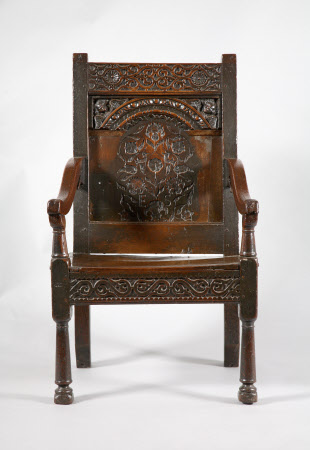Panel-back armchair
Category
Furniture
Date
circa 1630
Materials
Carved, turned and joined oak
Measurements
100 x 59 cm
Place of origin
England
Order this imageCollection
Hardwick Hall, Derbyshire
NT 1128059
Summary
An oak panel-back armchair, English, circa 1630, once inlaid to the back panel, and with uprights beneath the panel's arch, now also lacking. The rear uprights extending above the level of the toprail, which sits between them and is carved with flowerheads amidst addorsed foliate scrolls, the arch to the back panel with cherub spandrels, the panel with a now vacant design of flowers and foliage, and the initials 'ES', the arms downswept and on simple broadening column arm supports, the seat boarded above a seat rail carved with foliated 'S'-scrolls, on comforming simple columnar supports, the feet lacking/cut down. The inventory initials 'GC' to front left leg. -- Much of the 16th and 17th century oak at Hardwick Hall, the indigenous pieces aside, was probably purchased by the 6th Duke in the 19th century to enhance the Elizabethan feel of the property, much as his contemporary, Charles Winn of Nostell Priory, is known to have done (Westgarth, Raikes). The 6th Duke is recorded, for instance, as having bought 'oak Arm chairs' in 1846.
Provenance
By descent until, following the death of Edward William Spencer Cavendish, 10th Duke of Devonshire (1895 - 1950), Hardwick Hall and its contents were accepted by HM Treasury in part payment of death duties and transferred to the National Trust, in 1959.
Marks and inscriptions
Front leg: Inventory initials 'GC' Back panel: Initials 'ES' - once inlaid
References
Westgarth 2009, M. Westgarth, 'A Biographical Register of Nineteenth Century Antique and Curiosity Dealers', Regional Furniture XXIII (2009), 1 - 205 Raikes, 2003: S.Raikes. ““A cultivated eye for the antique”: Charles Winn and the enrichment of Nostell Priory in the nineteenth century.” Apollo 157.494 (2003): pp.3-8.
